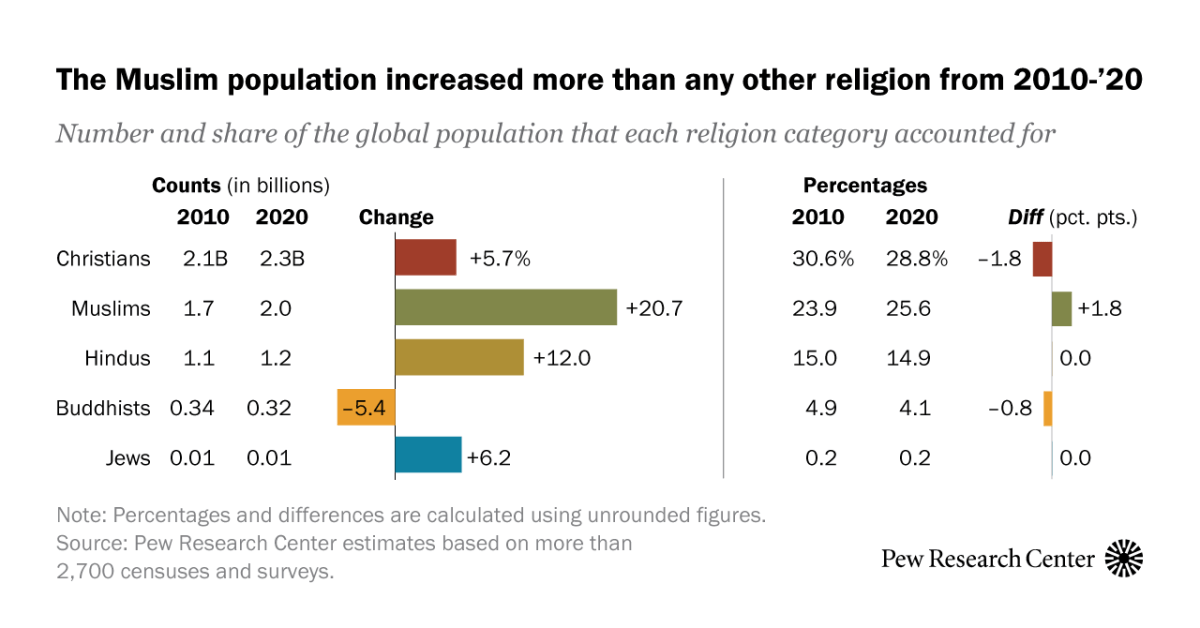Numbers, Facts and Trends Shaping Your World
Read our research on:
Full Topic List
Read Our Research On:
|
Muslims grew faster than any other major religious group in the decade leading up to 2020, according to new Pew Research Center estimates. Muslims continued to be the second-largest religious group in the world after Christians.
From 2010 to 2020, the number of Muslims increased by 347 million people to 2.0 billion people. Christians grew by 122 million to 2.3 billion. Buddhists are the only group in our analysis that shrank in absolute numbers, by 19 million people, to 324 million.
This Pew Research Center analysis describes changes in Muslim populations between 2010 and 2020. It is based on more than 2,700 sources of data, including national censuses, large-scale demographic surveys, general population surveys and population registers.
Our estimates cover 201 countries and territories that had populations of at least 100,000 people in 2010 or 2020. Collectively, these places are home to 99.98% of the world’s population. Data on country population totals come from the 2024 revision of the United Nations’ World Population Prospects.
This work is part of an ongoing series of studies produced by Pew Research Center for the Pew-Templeton Global Religious Futures project, which analyzes religious change and its impact on societies around the world. Funding for the Global Religious Futures project comes from The Pew Charitable Trusts and the John Templeton Foundation (grant 62287). This publication does not necessarily reflect the views of the John Templeton Foundation.
Here is the full Methodology. Our interactive website allows you to explore the data in more detail.
Our estimates covered 201 countries and territories that are home to 99.98% of the world’s population. We focused on seven groups of people: Christians, Muslims, Hindus, Buddhists, Jews, adherents of all other religions, and people who do not identify with any religion.
Muslims added more people during the decade (347 million) than all non-Muslim religions combined (248 million). In fact, the growth in the Muslim population exceeded the total number of Buddhists worldwide in 2020 (324 million).
As a result of the rapid growth of the Muslim population, the gap between the global number of Muslims and Christians is shrinking. In 2010, Muslims made up 23.9% of the world’s population and Christians accounted for 30.6%. By 2020, Muslims accounted for 25.6% and Christians 28.8%. Growth in the number of Christians was slowed by high rates of disaffiliation.
The global Muslim population grew rapidly because of demographic factors. Muslims have more children and are younger, on average, than members of any other major religion. Based on data for the 2015-2020 period, we estimated a Muslim woman would have 2.9 children, on average, in her lifetime, compared with 2.2 children per non-Muslim woman. In 2020, the global median age for Muslims was nine years below the non-Muslim median (24 vs. 33).
At the global level, Muslim population change has little to do with people converting into or out of the faith. Based on survey data collected in 117 countries and territories from 2008 to 2024, we estimate that about 1% of people who are raised Muslim leave the faith. This loss is offset by a comparable influx of people joining Islam.
In 2020, the greatest number of Muslims lived in the Asia-Pacific region (1.2 billion), followed by the Middle East-North Africa region (414 million). Sub-Saharan Africa’s 369 million Muslims made up the third-largest regional Muslim population. The Muslim populations in Europe and North America are much smaller, though they grew much more rapidly from 2010 to 2020 than the non-Muslim populations in these regions.
The region where Muslims made up the largest share of the population in 2020 was the Middle East and North Africa, where they accounted for 94% of the regional total. Still, while Islam is closely associated with the region, it is home to only about a fifth of Muslims worldwide.
The countries with the most Muslims in 2020 are all outside the Middle East-North Africa region: Indonesia (239 million), Pakistan (227 million), India (213 million) and Bangladesh (151 million).
Worldwide, Muslims are a majority of the population in 53 countries and territories.
Hackett, Conrad. 2025. “Islam was the world’s fastest-growing religion from 2010 to 2020.” Pew Research Center. doi: 10.58094/yy8g-2490.
Topics
Conrad Hackett is a senior demographer and associate director of research at Pew Research Center.
901 E St. NW, Suite 300
Washington, DC 20004
USA
(+1) 202-419-4300 | Main
(+1) 202-857-8562 | Fax
(+1) 202-419-4372 | Media Inquiries
ABOUT PEW RESEARCH CENTER Pew Research Center is a nonpartisan, nonadvocacy fact tank that informs the public about the issues, attitudes and trends shaping the world. It does not take policy positions. The Center conducts public opinion polling, demographic research, computational social science research and other data-driven research. Pew Research Center is a subsidiary of The Pew Charitable Trusts, its primary funder.
© 2025 Pew Research Center
We use cookies and other technologies to help improve your experience; some are necssary for the site to work, and some are optional. Lean more in our privacy policy.
These cookies are required for the website to function and cannot be switched off.
These cookies are used to collect information about how you use our website.
These cookies are used to track your activity and show you personalized content.
These cookies allow the website to remember choices you make.
